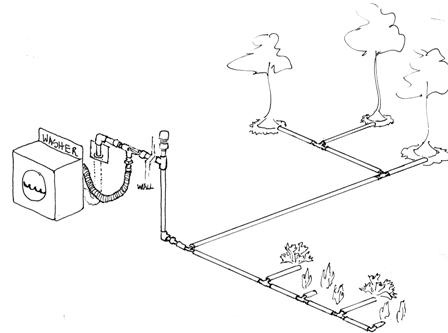South City resident Lawrence Heaton recently asked about water rules or ordinances in our city. This brought about a good conversation on our FB page yet we were still left wondering how to utilize greywater from our indoor plumbing to our outdoor needs. When using biodegradable products our bath/shower water and laundry water waste is still good to use on outdoor landscaping.
Thanks to Amanda Kesner-Hays for her researched share with this information: The SF PUC has information about grey water on their website, but remember that some of it is specific to the City and might not apply here. After checking out the information we realized it was too good not to share to help others find additional ways to save water – and landscaping!
As Amanda points out, much of this information is specific for San Francisco yet there is some great information on utilizing washing machine water for outdoor use. We have contacted our city departments for more specific information for South San Francisco and will update as more details are known.
Graywater Basics
Graywater is a unique source of water and must be used differently from potable water and
rainwater. These are some basic guidelines for residential graywater systems:
Do not store graywater more than 24 hours. If you store graywater, thenutrients in it start to break down and create bad odors.
Minimize contact with graywater. Graywater can contain pathogens. All systems must be designed so that water soaks into the ground and is not accessible to contact by people or animals. Infiltrate graywater into the ground; do not allow it to pool or run off.
You’ll need to know how fast water soaks into your soil to properly design your system. Pooling graywater can provide opportunities for mosquitoes to breed, as well as for human contact.
Keep your system as simple as possible. Simple systems last longer, require less maintenance, use less energy, and cost less. Keep in mind that systems with pumps and filters require more commitment and regular maintenance. Install a diverter valve at a convenient location to allow for easy switching between the graywater system and the sewer system.
Match the amount of graywater directed to your plants with their irrigation needs. See Appendix C for information about plant-friendly products; many products contain salts and boron, which harm most plants.
Graywater Regulations
Graywater use is legal in California. In August 2009, California’s graywater regulations changed, allowing for lower-cost graywater systems to be installed legally, including some without the need for a permit. In San Francisco, a permit is not required for a laundry graywater system that meets the conditions listed in the next section, “When a Permit Is Not Required.” For information about systems that do require permits, see the following section, “When a Permit Is Required.” California’s regulations for residential graywater systems can be found in Chapter 16A of the California Plumbing Code.
When a Permit Is Not Required
You can install a graywater system for outdoor irrigation without a permit if you meet all of the following requirements:
Graywater comes from the washing machine only.
Graywater system does not alter the household plumbing (you access graywater from the hose of the machine, not by cutting into the
plumbing).
Graywater system is for a one- or two-unit residential building.
Graywater system follows 12 guidelines set forth in the California Plumbing Code (see Appendix B, “Operation and Maintenance Manual for Laundry-to-Landscape Graywater System”)
When a Permit Is Required
You need a permit for a graywater system for outdoor irrigation that includes any of the following conditions:
Graywater system collects water from showers, sinks, or baths.
Graywater system alters the plumbing (you cut into the drainage plumbing to access the graywater).
Graywater system is installed in a building that is not a one- or two-unit residential building.
Graywater system includes a pump (besides the washing machine’s internal pump) or a tank.
For additional information about permitting a graywater system, contact the Department of Building Inspection at 415-558-6088 FOR SAN FRANCISCO RESIDENTS ONLY. SSF DOES NOT HAVE A PROGRAM AT THIS TIME
References
California Residential Graywater Code: California Plumbing Code, California Code of
Regulations Title 24, Part 5, Chapter 16A. Available at http://www.hcd.ca.gov/codes/shl/2007CPC_Graywater_Complete_2-2-10.pdf
Cohen, Yorem, 2009. Graywater—A potential source of water. UCLA Institute for the
Environment.
Available at http://www.ioe.ucla.edu/reportcard/article.asp?parentid=4870

Hello, my name is James and I’m an assistant in the Education & Engagement Program, at the Ecology Center, in Berkeley, CA. We are collecting a list of businesses working in the greywater catchment and rain water harvesting area (in the broad general Bay Area).
Do you have a list of businesses that you recommend ? How do you refer businesses doing design, installation and maintenance, in this field, to those parties interested in lowering their public water usage ?
Thanks, James Wed. & Thurs. Noon – 5PM only (Email is best)
[…] UPDATE ON GREYWATER CLICK HERE […]